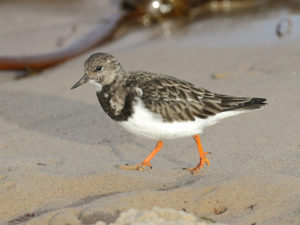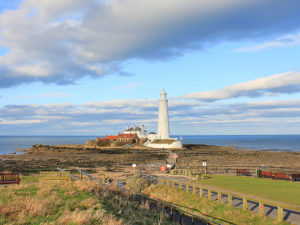Friends of Red Kites – Media Release Aug 2025
Did you know … the red kite has an eye for white ?
Old folklore, and Rossini’s opera “The Thieving Magpie”, suggests that magpies are drawn to shiny objects. Research, from the University of Exeter, indicates that these birds actually tend to avoid such items !
However, the red kite’s attraction to white objects has been well documented since the Middle Ages, when these birds were a familiar sight in both rural and urban Britain. At that time, people did their washing in rivers and often left it to dry on riverbanks, making it easy for red kites to swoop down and collect white linen for their nests. Shakespeare himself references this behaviour in ‘A Winter’s Tale’ (Act 4, Scene 3): “When the kite builds look to your lesser linen.”
Our dedicated volunteer teams regularly visit red kite territories in the Derwent Valley, Northumberland and Durham. The work begins in early March with locating the nests, followed by continuous monitoring until the chicks are ringed and wing-tagged, prior to fledging, in early June. Experienced tree-climbers are employed to access the nests, at which point their contents are revealed, and gently lower the chicks down to the licenced ringers/taggers below.
Some of the white items discovered in red kite nests are: an England football flag, a woolly hat, white socks, PVC gloves, a plastic bag, a pillowcase, baler twine, a dishcloth, a disposable nappy and a soiled pair of men’s underpants !
The Friends of Red Kites (FoRK) was formed when the Northern Kites project finished in 2009. It is purely voluntary and continues with the conservation and monitoring of the species whilst encouraging community involvement with the work we do.
Website www.friendsofredkites.org.uk
NTBC Photographic Competition 2024
The Northumberland & Tyneside Bird Club are pleased to announce that there will be a
photography competition for photographs of birds in the Northumberland & Tyneside
recording area taken during in calendar year 2024. Entries must be submitted by January
31st 2025 and the results will be given at the Indoor Club meeting at McCracken Park Gosforth
on April 10th 2025.
Entries will be judged by Rob Jordan.
Rob has had a passion for nature, particularly birds since childhood and has been
photographing wildlife for over 50yrs. He has received many awards from the NHM/BBC
Wildlife Photographer of the Year Awards and has also judged and been a featured
photographer in a BBC programme for that competition. He’s lectured widely including
the prestigious festivals for nature photography in Kuusamo, Finland, the GDT
(European Nature Photography awards) Germany, the BVNF festival in Belgium and the
members of the Natural History Museum in London.
Rules of Entry
A maximum of three images may be submitted. The images must be of birds taken in the
Northumberland & Tyneside bird club recording area in 2024 and must be numbered from 1-
3 in order of the author’s priority. This is in case we need to limit the number of images for
judging.
The bird must be in its natural setting in the wild; images of captive birds are not allowed.
We encourage the submission of images that are not purely illustrative but go beyond into
the artistry of bird photography that perhaps captures the essence of the subject, some
movement or motion, a fleeting moment in time or unusual behaviour or some exceptional
lighting.
The subject species and location should be clearly included in the file name (sensitive
species locations will not be made public). The file extension should be .JPG or .jpg and the
image saved in sRGB colour space.
Please DO NOT include your own name in the file name.
Images should be sent via e mail to ntbcphoto@gmail.com to arrive by 31 st January 2024.
Images submitted after this date will be excluded.
The processing of images must be limited to cropping, exposure adjustment, colour
correction, noise reduction, dodging/burning, HDR, focus stacking and sharpening. Cloning
of image defects and minor distractions is permitted but it must not distort the truth of the
photographic statement.
The judge’s decision is final.
Entrants must provide their e mail address and contact phone number.
The Northumberland & Tyneside Bird Club reserves the right to publish submitted images in
publications or social media which promotes the Bird Club and in our monthly bulletin and
annual Birds in Northumbria. No images will be used by the Northumberland & Tyneside Bird
Club for commercial gain without the express written permission of the author.
To download a copy of the conditions and rules of entry click here
NEW COLLECTION BOX AT FAMED VICARAGE GARDEN SITE
A new donations box has been installed at the Vicarage garden on Holy Island to allow visiting birders to
the Northumberland hotspot to show their appreciation of the rarities and more regular migrants it
attracts.
The old box, installed in 2019, eventually succumbed to wind, rain and rust after five years of raising
funds for the upkeep the island’s parish church, St Mary’s, which dates back to the Anglo-Saxon era.
With its priory and castle, the island is regarded by many birders as the region’s best birding locality. The
island is, of course, also regarded as the cradle of Christianity in the north and was the scene of the first
Viking raid on England in 793. The island is also famed for the Lindisfarne Gospels and its associations
with saints, including Aidan and Cuthbert. The church remains a destination for pilgrims for across the
world.
The nearby garden has a mouth-watering bird list, particularly of rare spring and autumn migrants, and
no visit to the island and the surrounding Lindisfarne National Nature Reserve can be regarded as
complete without it being checked.
The garden regular attracts Yellow-browned Warblers in September and October and parties of
Goldcrests can occasionally attract Firecrests. But over the years the garden’s Sycamores, willows and
shrubs have also pulled in many much rarer species including Pallas’s, Arctic, Radde’s, Dusky, Subalpine,
Greenish and Icterine warblers. Red-backed and Great Grey shrikes, Common Rosefinches and
Hawfinches are also on its list.
The garden also hosted Northumberland’s one and only Eastern Black Redstart in 2011 and has also held
Red-flanked Bluetail, much to the annoyance of aggressive Robins. More unusual species for a garden
include Nightjar and Kingfisher.
The garden also attracts large numbers of common migrants and on one wet day last October there
were spectacular counts of over 3,500 Redwings per hour passing overhead south westwards to the
mainland.
The garden is private but the stone wall along its southern edge, where the box is fixed, is at ideal
leaning height for binoculars, giving birders a great view.
The garden provides the best cover in the south west corner of the island, often picking up north-bound
visitors in spring and south-bound migrants in autumn. Autumn birds tend to filter across the island,
often ending up in the garden before making the short hop to the mainland across the mud and sand
flats of the reserve.
The vicar, Canon Dr Sarah Hills said that the old box had been a tremendous help in fund-raising for the
church which like all old buildings was in constant need of repair.
“We want everyone to go on enjoying the garden and its birds and we’re always grateful when visitors
help out with a donation,” she said.
The original box was installed by island birder Ian Kerr and Max Whitby, head of NatureGuides,
publishers of his Birds of Holy Island and, recently, Plants of Holy Island by Chris and Hazel Metherell.
The new box, hopefully more weather-resistant, was installed by Ian and Max with assistance from
friend and island neighbour Ian Black.
The third hardback and expanded and updated edition of Ian’s book is due out this summer with a
species list now standing at 353. A new feature of the third edition will be colour plates of typical island
species, including Eider and Short-eared Owl, by award-winning artist Chris Rose who regularly visits the
island.
Photos – Max Whitby
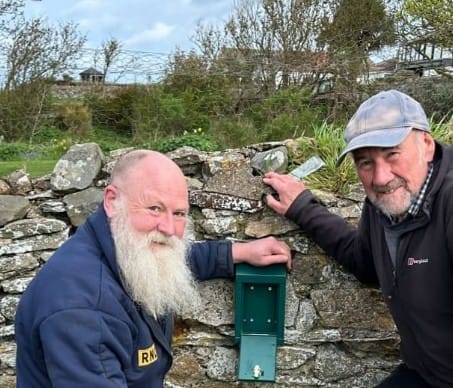
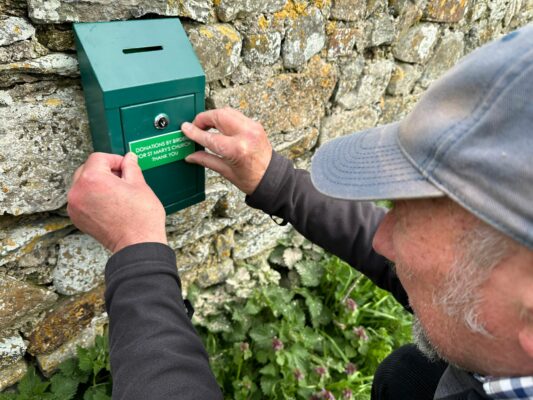
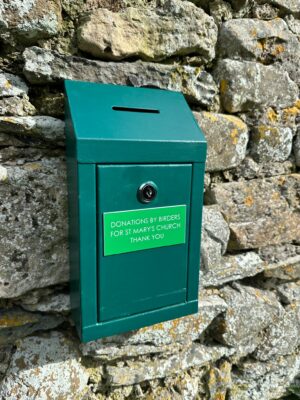
Northumberland & Tyneside Bird Club Bird Race
January 6th 2024
The traditional “first Saturday of the year” Northumberland & Tyneside Bird Club Bird race took place on January 6th. Ten teams entered, including last year’s winners, Phil Allot, Gary Storey, Cain Scrimgeour and Heather Devey, with the powerful team of Jack Bucknall, Michael Murphy, Dan McGibbon and Andy Kinghorn seeking to regain their crown.
As usual, a number of teams were at Fenham-le-Moor at dawn. Although a number of key species were present, including Pintail, Barnacle Geese were not absent as they were from the view point at Harper’s Haugh. In fact, only two teams connected with Barnacle Goose on the day and only one team saw the wintering Red-breasted Goose late in the day.
Various teams met up during the remainder of the day at some of the specialty sights; 3 teams connected with Little Owl at a traditional site in the south east of the county and 4 teams were at Newbiggin Golf Course for the 2 wintering Shorelark’s, Twite and Skylark. Interestingly the winning team decided not to try for the Shorelark’s preferring to spend their time on other species. Newbiggin Bay was a good place to catch up with waders missed earlier in the day, notably Grey and Golden Plover; one team recorded a fly-by juvenile Gannet there too.
A number of scare wintering birds were recorded by teams; Waxwing, Iceland Gull and American Wigeon were all recorded and two teams managed to connect with a brief appearance by a Black-throated Diver at Druridge Pools sportingly put out by the first team to see it – well done!
One team concentrated their efforts in the south west of the county venturing no farther than Druridge Bay Country Park in the north and Gosforth Park Nature Reserve in the south, recording 111 species, their highest score in many years.
During the day a cumulative total of 136 species was recorded with 4 species being recorded by only one team; Red-breasted Goose, Iceland Gull, Long-eared Owl and, perhaps most interestingly Great Skua was seen as a fly-by off Stag Rocks.
The day ended at The Keel Row, Seaton Delaval with 7 of the 10 teams meeting up to reveal their scores. Last year’s defending champions had a magnificent 116 but the clear winners were Jack Bucknall’s team with 121.
Thanks to all who took part and each team had a great day out; why not join in next year on January 4th 2025.
| Team | A | B | C | D | E | F | G | H | I | J |
| Species | 104 | 108 | 121 | 90 | 83 | 108 | 116 | 111 | 107 | 103 |
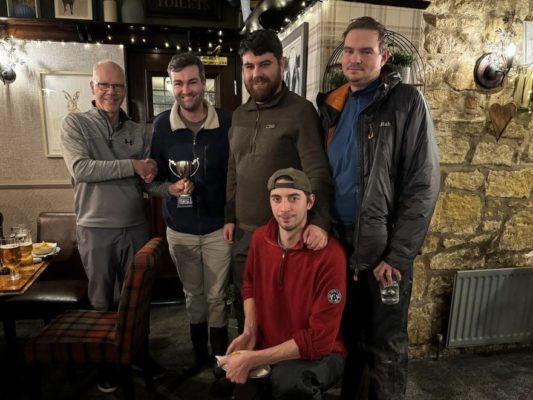
Lars Svennson visits Holy Island
By Ian Kerr
Lars Svensson, whose name will be well known to every serious birder and ringer throughout Europe and beyond, recently made his first visit to one of our own local hotspots, Holy Island – and he was very impressed with the place. He found the whole island very beautiful and was impressed both with its varied habitat and the island’s and Lindisfarne NNR’s range of species, now standing at 350. Unfortunately, he was just too late for the peak of autumn migration although watching our waders and wildfowl was adequate compensation. During his weekend visit, his host, Max Whitby, and I had the pleasure of showing him parts of the island, including the Heugh and harbour, the North Shore and the Causeway area where we watched waders and wildfowl moving in response to the rising tide. Lars came to the island while in Britain for a couple of weeks working on a project which involved examining hundreds of bird skins in the Natural History Museum’s collection.
We couldn’t have timed his visit the Heugh for a better time as it coincided with the unexpected appearance of a pair of Ravens, a species very familiar to him from Sweden. While he was there they turned up and for half an hour busily and very noisily prospected the ruins of the Priory below, apparently looking for a nesting site. By co-incidence, that same morning I was giving a completely non-scientific presentation in St Mary’s parish church, on the “The Birds of the Lindisfarne Gospels.” This was part of island celebrations to mark the return to the region of the early masterpiece of Anglo-Saxon art and literature which was on show at the Laing Art Gallery, Newcastle.
Having such a prominent birder in the audience was a bit daunting but turned out to be very fortuitous. Lars was able to confirm my belief that one of the finest illustrations in the Gospels, the Eagle of St John, was based upon a White-tailed Eagles rather than Golden Eagle as experts have previously thought. After checking beak colour and fringing to the throat and breast markings, Lars was able to confirm it as a sub-adult, probably around three years old. It’s long been believed that Bishop Eadfrith, credited with producing the Gospels, probably had a live eagle to work from and Lars’s comments about the accuracy of details seems to give added confirmation to that theory.
White-tailed Eagles are an everyday sight for Lars as he has a nest site he can watch from his home on one of the Swedish islands where he’s also adapted his house roof to accommodate nesting Oystercatchers.
I first became aware of Lars huge contribution to birding back in the 1970s when, as a trainee member of the Northumbria Ringing Group, I became the proud owner of a copy of the small orange-backed second edition of his Identification Guide to European Passerines, a highly scientific little volume invaluable to ringers because it contained so much information about plumage, weights, measurements and other details. It was constantly referred to at Hauxley ringing station and other localities where we used our mist nets.
Like the other copies of that edition, it came with a pasted-in page giving an index of the English bird names provided by the British Trust for Ornithology (BTO) for the benefit of ringers.
Lars was fascinated to hear that I still had this little book on my shelves – and was still using it from time to time for reference despite the availability of so many other more modern publications and reports and, of course, the wealth of information on the internet. Apart from St John, the White-tailed Eagle was also used as a symbol of strength and power by the Romans who they came to Britain and they were later one of the favourite standards of the Vikings whose arrival on Lindisfarne in 793, their first raid on England, was to have such momentous implications for our history. Fortunately for us today, the Vikings either didn’t come across the Gospels or if they did, ignored them as being of no value.
793 is largely forgotten in Britain’s history, except of course on Holy Island, but in Scandinavia it is regarded as the start of the Viking Age with its impact on so much of Europe, Iceland, Greenland and perhaps even North America. Much earlier, the same eagles were obviously important for perhaps religious or superstitious reasons to the Neolithic people of Orkney where the beaks and talons of 20 eagles were found in a tomb containing the remains of 300 people dating back to 2,000BC.
Later the Eagle of St John was also adopted by the first Christian rules of the newly united Spain, Ferdinand and Isabella. They’re, of course, best remembered for commissioning Christopher Columbus to set off and find a new sea passage to India. Well, we all know how that turned out even if the Vikings had probably beaten him to it many centuries earlier!
Lars is best known to today bird-watching community for providing the species write-ups and maps for the birders’ “bible,” Collins Bird Guide, which has sold over 1.2 million copies in 27 languages since it was first produced in Swedish in 1999, the result of 15 hard and dedicated years work by in partnership with Killian Mullarney, Dan Zetterstrom and the late Peter J Grant.
The latest updated and expanded edition was published in late 2022 just at the time Lars was guest on the island of Max, co-founder of BirdGuides and now head of NatureGuides, publishers of my own book, The Birds of Holy Island. A new updated edition is due out in 2023 containing details of all species so far recorded on the island and the Lindisfarne National Nature Reserve.
Max’s company has, among many other projects, digitised the Collins guide as well as the famous BWP – covering the birds of the Western Palearctic. Another of its publications, a guide to the impressive flora of Holy Island, is also due out in 2023.
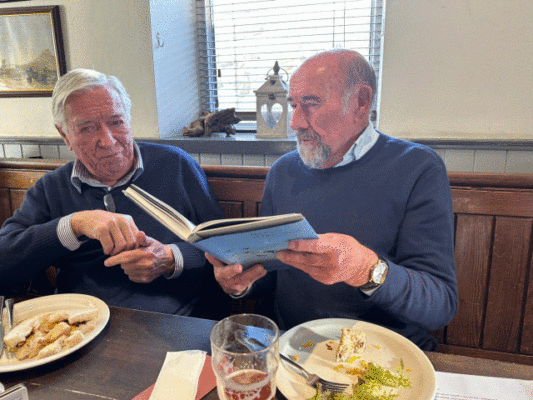
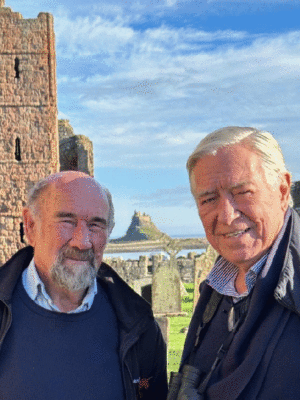
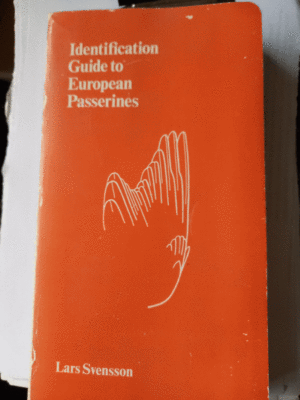
Discussions over lunch at the Crown & Anchor Lars and Ian outside St Mary’s Church The famous orange guide invaluable to ringers
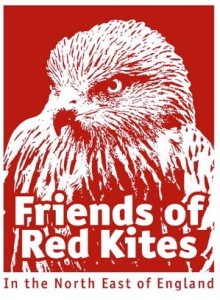
Friends of Red Kites
MEDIA RELEASE – Red Kites Roosting
The Friends of Red Kites (FoRK) are pleased to report that, in participating in the National Red Kite Roost Count on Sunday 9th January, 20 volunteers surveyed 8 locations in the Derwent Valley and beyond, achieving a best ever count of 94 red kites.
Many birds of prey are gregarious, particularly outside the breeding season, but the Red Kite, its close relative the Black Kite and several of the vultures, take this behaviour to the extreme where communal winter roosting is typical. The majority of red kites across a wide area come into the same roost site at dusk. It is likely that the red kites benefit from loose communal gatherings by being able to forage for food in loose groups the following morning. Roosts may also serve as a place for young red kites to interact with potential future mates.
Two main roosts were identified: one near to Hamsterley Mill, where 71 red kites were counted (also a record for one location) and the other lower down the Derwent Valley, just off the Derwent Walk. For those locations with zero or one or two red kites remaining on territory, this is still valuable information adding to our knowledge of kite behaviour. It was noted, with concern that 3 red kites had damaged feathers giving rise to suspicions that they may have been shot.
Ken Sanderson, FoRK Chair and Kite Officer, said “This is a fantastic result which supports the notion that our red kite population is still increasing. Let’s hope the numbers will continue into the breeding season.”
If you are aware of a red kite roost then please do let FoRK know: www.friendsofredkites.org.uk
Northumberland Winter Bird Race 2020
An amazing nine teams, 34 individuals, braved the cold on Saturday 4th January 2020 for the annual Northumberland Winter Bird Race, this must be a record number of teams, which proved to be a ‘trying day’ made difficult by the nagging and persistent wind which forced the small birds to keep their heads down a little more than normal.
As per usual there was a great diversity of strategies. As well as the popular and traditional areas a number of teams had been out reconnoitring and coming up with a number of favourite sites for possibly tricky species. However, it is interesting that seven out of the nine teams went out of their way to see the Eastern Yellow Wagtail that had been performing so well at Prestwick Carr. It’s worth noting that all species only count as one but a ‘good’ bird is hard to resist, in fact it was a lifer for several Racers.
Several new species were added to the Winter Bird Race list this year; Ring-necked Parakeet and Raven are two in particular which possibly reflects the increase in populations. We always get a sprinkling of rare and scarce birds and of course the afore mentioned Eastern Yellow Wagtail falls into the category as does Black Redstart and Water Pipit. No white winged gulls this year, although one or two had been seen prior to the turn of the year. Some common species, such as Greenfinch, proved difficult to find which again probably indicates the decline in the population.
The winning Team, again, Jack Bucknall, James Common, Dan McGibbon and Michael Murphy with a magnificent 115. After winning for at least three years in a row, this team of bright-eyed birders got to keep the trophy. Six teams broke the 100 threshold, which must be a record, and the combined species list for all nine teams stands at a very impressive 135 species.
Thank you all for taking part and If you’d like to join in for 2021 Winter bird race then put the 9th January in your diary and watch out for the notices.
Tom Cadwallender
» Click here for the Birdrace species list

Friends of Red Kites
MEDIA RELEASE – Red Philip deceased
The Friends of Red Kites (FoRK) has announced that, sadly, one of their “founder” red kites, Red Philip, has had to be put to sleep following a serious injury.
Click here to read the press release
Friends of Red Kites
MEDIA RELEASE – Operation Owl launched
Operation Owl is a national campaign currently operating in 25 police forces in which the public are being asked to help tackle the unlawful persecution of birds of prey (beit by shooting, trapping or poisoning) and report incidents to their local Police force.
Operation Owl is now underway in the Northumbria Police Force area and two successful launch events were held recently at Kielder Waterside and Haggerston where representatives from Northumbria Police, the RSPB and Friends of Red Kites were present and engaged with members of the general public to show support for, and take action as part of, Operation Owl.
» Click here to read the press release
Northumberland Winter Bird Race 2019
Saturday January 5th was a good day; it was Winter Bird Race Day. Seven teams set off, with various fine tuned strategies, to see as many species as they could in the hours that were available. Weather was relatively benign, and some would say even warm. However in exposed places such as Stag Rocks, Bamburgh, some individuals fastened their jackets and needed to put their gloves on!
One of the interesting things about winter bird racing is that the ‘birding deck’ is shuffled every year. The received wisdom, for example, is a ‘kind of you know’ where the Purple Sandpipers should be but there is no guarantee that they will be there when you go looking for them. More significantly there are always the birding wild cards of rarities, scarcities and flybys to add to the mix. That was again the case on the 5th January. Teams have their favourite sites, these are combined with traditionally good sites for certain species and some sites, which are temporary home for ‘exotic’ species, are all reccied before the big day.
So with reccies all done, some teams started and stayed in the south of the county, others started in the north and headed south, whilst one team started inland then headed east. Many miles were driven scouring the various habitats for birds with one team actually walking 10 miles, as well, during the birding quest.
Meeting back at the Keel Row, near Seaton Delaval, after dark for the official ‘Call Over’ much ‘craic’ and a couple of beers was had before the wining team (See results below) was declared and the Trophy presented. On the day, seven teams ‘raced’ with a total of 25 team members, and they are listed below. Well done to the winning team, Jack Bucknall, James Common, Sacha Elliott, and Dan McGibbon, who found 109 species; with the combined list of all teams reaching a total of 131 species recorded. However there were some obvious gaps in the combined list with, for example, Gannet, white-winged Gulls, Kittiwake and Skylark going unrecorded. Other species that were in the county but were missed included Ruff, Spotted Redshank and Hooded Crow to name but three. But it’s forever a case of ‘what might have been’.
Before dispersal everyone agreed it had been another very enjoyable day and a great way to start the year and all vowed to do it all again next year on Saturday January 4th 2020. Will you join them?
Tom Cadwallender
Participating Teams
- Winners; Jack Bucknall, James Common, Sacha Elliott, Dan McGibbon
- Neil Anderson, Muriel and Tom Cadwallender, John Richardson
- Gary Storey, Cain Scrimgeour, Phil Allott
- Bob Biggs, Hector Galley, Roger Forster, Steve Scott
- Graeme Bowman, Dee McKeown, Les Robson
- Graham Sorrie, Roz Dunn,(one team members name removed temporarily)
- Liam Gormley, John Harrison, Paul King, David Southern
» Click here for the bird race species list
Turnstones ringing at Druridge Bay
‘As part of a project with Newcastle University studying the ‘home range’ of Turnstones we’ve been colour-ringing, with yellow flag (and Radio tagging) at Druridge Bay.
We’re now at a point where would encourage reporting of any sightings. If you do see any could you please note ring combination, grid reference and location and date and time and let me know.
You may see me wandering about with waving an aerial around tracking as well, if so please say hello.
Tom Cadwallender
St Mary’s Island
Changes to Access Arrangements for the hide on the Island
The NTBC committee has been informed by Mr Adam Kelsey, the Manager of St Mary’s Lighthouse and Visitor Centre, of forthcoming changes to the access arrangements to the hide on the Island. The relevant part of his email is quoted below.
“Previously keys to the hide have been sold by the Council to allow access to hide outside of normal lighthouse opening times, but although this practise was stopped some time ago, it has come to the attention of Council officers that some of the keys issued before this point have been copied and circulated to other users. To this extent the council therefore no longer has any control over access to the hide, resulting in instances where the hide is in use without council staff present to supervise, which could potentially result in instances of misuse and the inability to respond in the event of an urgent incident.
As such following a review of operations it has been decided that the locks to the hide will be changed to invalidate the keys in circulation and from that point access will be restricted to times when Council staff are on site to supervise operations. The hide will be opened throughout all normal openings of St. Mary’s Lighthouse and Visitor Centre and access outside of these times will still be permissible, either by prior arrangement or via direct communication with staff who are on site most days throughout the year, even outside of normal openings.”
The committee hopes that club members will cooperate with this protocol. Mr Kelsey can be contacted via email at Adam.Kelsey@northtyneside.gov.uk and by phone at 0191 200 8650.
Friends of Red Kites
Poisoning of Red Kites Condemned
Three red Kites have been found illegally poisoned in a blow to efforts to re-establish a thriving population across north east England.
» Click here to read the press release
Seaton Sluice Watch Tower
Seaton Sluice Watch Tower key duplicates are available to members. Costs have recently increased and from 2024 members may obtain keys for a £7-00 fee at any indoor meeting from the club Hon. Secretary Andrew Brunt, or another committee member. If this is not possible, contact him preferably by email and one can be posted, cheques payable to “NTBC”. Contact details are on the » contacts webpage. All are reminded that the tower is for club members use only.







